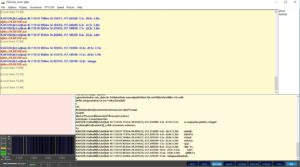FS3 Post Flight Post Summary

Two of the primary goals of every Flying Squirrels mission is to:
1. Have Fun!
2. Learn stuff.
We certainly had a lot of fun! A bunch of middle-aged hacker Geeks are never too old to play with a big balloon and laugh about it! And no matter the outcomes, we learn and use this information for the next mission.
I would have liked the FS3 telemetry to continue until it got back to ground. I had hoped to learn where the balloon might burst and how fast our squirrel would fall once it did.
Given the sudden loss of our telemetry data there are only a few possible scenarios:
- The balloon could have burst at 9,100 meters altitude and the antenna (33 ft of magnet wire in two halves) tangled up as the payload started free fall. This may have tangled up the two halves of the dipole antenna and effectively “shorted it out”, thus we could no longer hear the telemetry signals if they were still being generated onboard. Working with the 33ft of thin twisty magnet wire on the ground, it is not too hard to imagine this scenario.
- Something may have frozen causing catastrophic failure. Many of the parts inside the FS3 payload are rated down to -40c. The payload only got down to -12c inside. But many of the components on the boards are not rated and it is also easy to imagine they could fail at -12c. Other builders have reported that some of the surface mount parts like resistors and capacitors can “Just pop off” the board in the cold.
- Any air turbulence, jostling the squirrel violently, could break a wire or short something. Or maybe the battery popped out of its holder. It’s all possible.
Unless FS3 is found on the ground and returned, we will never know. That is unsatisfying to curious Ground Squirrels, but none the less we learned stuff. And the stuff we learned will shape the next payload and we will go on. Failure is an option. Failure can be good!
Given these the above scenarios there are things to do next time:
- We can make the antenna more free-fall resistant. Adding a streamer to the top end of the dipole will keep it pulled taught by providing air resistance to that end of the antenna. The bottom end may still tangle, but half an antenna should still work enough to know what happened.
- We now know that the payload got very cold. Was this a cause of failure? We don’t know, but had the balloon continued upwards, it would have eventually become cold enough to fail. We will need a heating system for the next flight.
- We can double down on making the wiring more secure inside.
Failure is a teacher
Lastly now that we know the possibilities above, we can do the research and testing to lessen the likelihood of these problems next time. I am motivated to build and test a squirrel cold test bed, freezing the payload and see what might fail and finding ways to heat it. I will build a payload and shake it violently to be sure the wires wont short/break etc.
Something failed on FS3, but the mission was not a failure because we learned from it.
73s de Don KJ6FO
